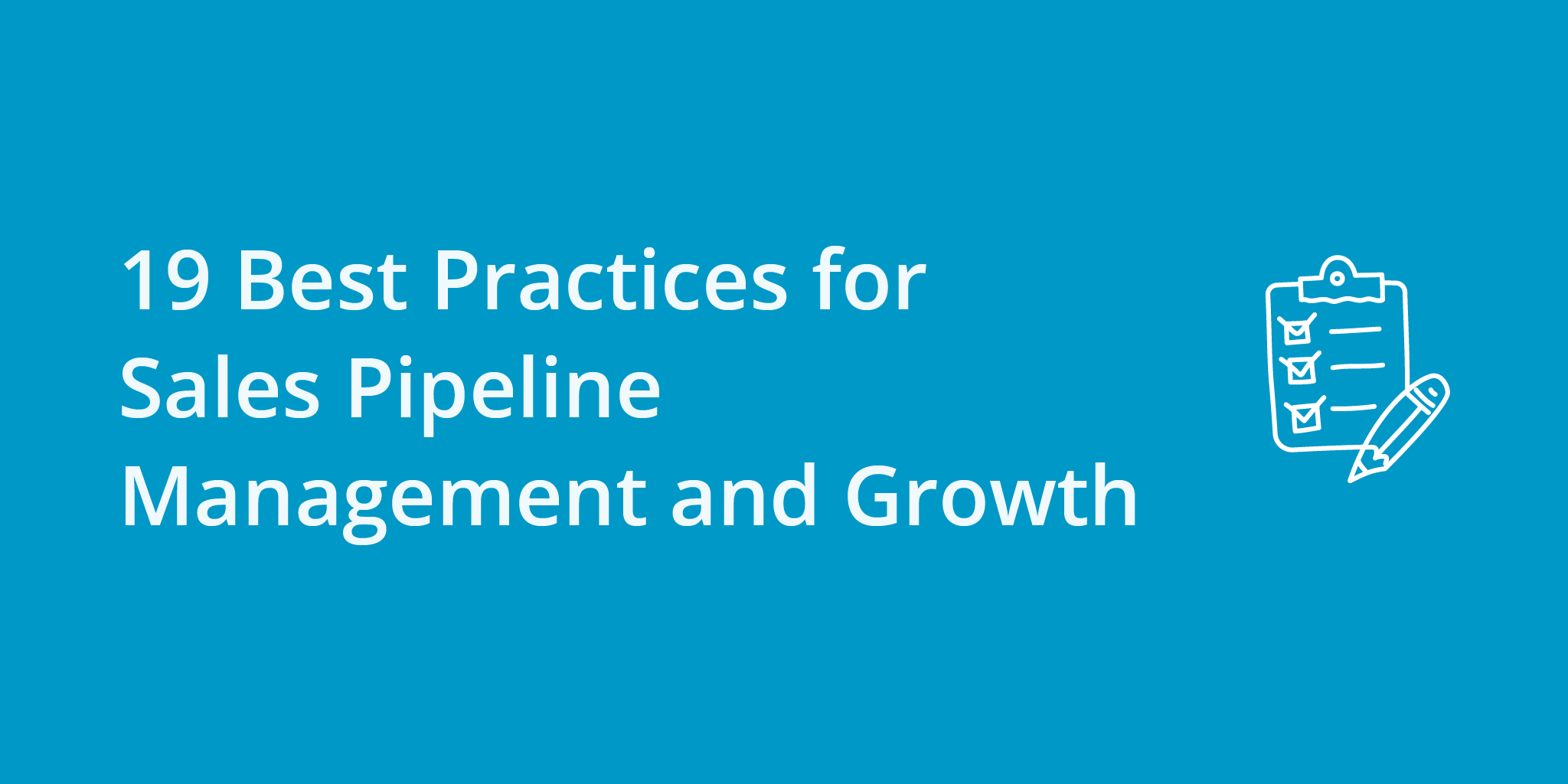- What are the Stages of a Simple Sales Pipeline?
- How to Manage Your Sales Pipeline
- How to Build Sales Pipeline
A sales pipeline refers to the systematic and visual representation of the entire sales process, from prospecting potential customers to closing deals. It consists of multiple stages or phases that reflect the progress of a sales opportunity from initial contact to successful conversion.
The sales pipeline serves as a framework to track and manage sales prospects at each stage, providing a clear overview of where each opportunity stands in the sales cycle. It helps account executives and sales development representatives prioritize their efforts, allocate resources effectively, and forecast future sales revenue.
In this article, we’ll take a look at 19 best practices for not just maintaining your sales pipeline, but also growing sales pipeline for effective revenue generation.

What are the Stages of a Simple Sales Pipeline?
The pipeline stages typically include:
- Prospecting: Identifying and qualifying potential leads or prospects.
- Initial Contact: Making the first connection with a prospect and gauging their interest.
- Needs Analysis: Understanding the prospect’s requirements and evaluating if your product or service can meet those needs.
- Proposal: Presenting a tailored solution to the prospect’s needs and negotiating terms.
- Closing: Finalizing the agreement, addressing any objections, and securing the deal.
- Post-Sale: Nurturing the relationship with the customer, ensuring satisfaction, and identifying opportunities for upselling or cross-selling.
By visualizing the sales pipeline, account executives and sales development representatives can assess the health of their pipeline, identify bottlenecks, and take appropriate actions to keep deals moving forward. It enables effective sales forecasting, aids in setting realistic targets, and facilitates strategic decision-making to optimize sales performance.
How to Manage Your Sales Pipeline
Managing your sales pipeline effectively is crucial for driving sales success. Here are some best practices to consider. By implementing these pipeline management examples, you can enhance the effectiveness of your sales pipeline management, increase efficiency, and drive better sales results.
- Define Clear Sales Stages: Establish well-defined and distinct stages in your sales pipeline that align with your specific sales process. Clearly define the criteria for moving a prospect from one stage to another. This ensures consistency and a shared understanding among your sales team.
- Qualify Leads: Implement a robust lead qualification process to ensure you focus your efforts on prospects with the highest potential for conversion. Consider factors such as budget, authority, need, and timeline (BANT) to assess lead quality before investing significant resources.
- Regularly Review and Update: Continuously review and update your pipeline to maintain its accuracy. Regularly revisit and reassess the status of each opportunity, ensuring that they are assigned to the correct pipeline stage based on their current progress. This helps in identifying and addressing any bottlenecks or stalled deals promptly.
- Track Key Metrics: Monitor and measure important sales metrics related to your pipeline, such as conversion rates, average deal size, and sales cycle length. This data provides insights into the health of your pipeline, helps identify areas for improvement, and enables more accurate sales forecasting.
- Nurture Relationships: Focus on building strong relationships with prospects throughout the pipeline stages. Regularly engage with them, provide valuable information, address their concerns, and understand their evolving needs. Effective relationship nurturing increases the chances of closing deals and encourages customer loyalty.
- Utilize Sales Technology: Leverage sales automation and customer relationship management (CRM) tools to streamline pipeline management. These tools can help track interactions, automate follow-ups, set reminders, generate reports, and provide valuable analytics. Choose a system that aligns with your team’s needs and ensure proper adoption and utilization. If you’re on a budget, you can opt for a free customer management software.
- Train and Develop Your Team: Provide comprehensive training and ongoing professional development for your sales team. Equip them with the necessary skills and knowledge to manage the pipeline effectively. Foster a culture of continuous learning and encourage collaboration to share best practices and success stories.
- Foster Collaboration Between Sales and Marketing: Establish strong collaboration and communication between your sales and marketing teams. Ensure that marketing efforts align with the sales pipeline stages, and there is a seamless flow of leads from marketing to sales. Regularly exchange insights and feedback to refine targeting and messaging strategies.
- Implement a Sales Process Review: Conduct regular reviews of your sales process and pipeline management techniques. Identify areas that need improvement, gather feedback from your sales team, and make necessary adjustments. Continuously refine and optimize your sales pipeline based on the evolving needs of your business and market.

How to Build Sales Pipeline
If only there were a simple answer for how to build pipeline in sales! While we can’t give you a roadmap that will work 100% of the time, there are some tried and true sales pipeline generation strategies that you should consider (if you haven’t already).
Entire consulting organizations are designed to help businesses with sales pipeline growth, so don’t be discouraged if you can’t exponentially grow your pipeline on the first try.
To build a robust sales pipeline and grow leads in your sales funnel, sales and marketing teams can start by following these steps:
- Define Target Customer Profiles: Clearly identify your ideal customer profiles (ICPs) based on factors such as industry, company size, demographics, and pain points. This helps in targeting your efforts and resources more effectively.
- Conduct Market Research: Conduct thorough market research to identify potential prospects within your target market. Utilize market data, industry reports, online tools, and social media platforms to gather insights about potential leads.
- Develop a Lead Generation Strategy: Create a comprehensive lead generation strategy that combines various tactics and channels such as content marketing, social media marketing, email campaigns, search engine optimization (SEO), paid advertising, events, and partnerships. Tailor your approach to reach and engage your target audience effectively.
- Create Compelling Content: Develop high-quality, valuable content that resonates with your target audience. This can include blog posts, whitepapers, case studies, videos, infographics, and webinars. Share this content through your website, social media channels, and email campaigns to attract and capture inbound leads.
- Implement Lead Capture Mechanisms: Deploy lead capture mechanisms across your marketing channels, such as contact forms, gated content, newsletter sign-ups, and chatbots. Ensure these mechanisms are integrated with your customer relationship management (CRM) system to capture and manage leads efficiently.
- Qualify and Segment Leads: Implement a lead qualification process to identify and prioritize leads that have the highest potential for conversion. Utilize lead scoring criteria based on factors like demographic fit, engagement level, and buying signals. Segment leads into different categories based on their readiness and needs.
- Nurture Leads with Outbound: Develop a lead nurturing strategy using targeted email, calling, and social outreach campaigns. Send personalized and relevant content to educate and engage leads, gradually guiding them through the sales funnel. Use marketing and sales automation tools to automate and track these outbound campaigns.
- Enable Sales and Marketing Alignment: Foster close collaboration and communication between your sales and marketing teams. Define shared goals, establish clear lead handoff processes, and ensure a feedback loop to exchange insights and refine strategies. Regularly review and align on lead quality and progress.
- Leverage Sales Engagement Tools: Equip your sales team with sales engagement tools that provide them with the necessary resources, content, and training to effectively engage leads. This includes CRM systems, sales automation software, sales dialers, email templates, sales scripts, and conversational intelligence tools.
- Analyze, Optimize, and Iterate: Continuously analyze the performance of your lead generation efforts and sales pipeline. Monitor key metrics such as lead conversion rates, time spent in each pipeline stage, and revenue generated. Identify bottlenecks, experiment with different strategies, and iterate based on the data to optimize your pipeline.
Remember, building a sales pipeline is an ongoing process that requires continuous effort, measurement, and improvement. By following these steps and adapting them to your specific business needs, you can increase your chances of growing your leads in the sales funnel and driving revenue growth.
In Conclusion…
In summary, effectively managing a sales pipeline is crucial for sales and marketing teams to achieve revenue goals. By following the best practices outlines above for managing and growing sales pipeline, your business will be that much closer to creating a reliable revenue generating strategy.



